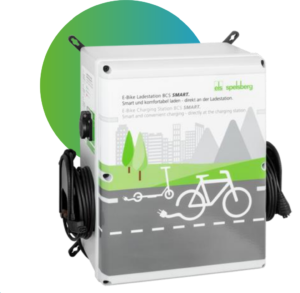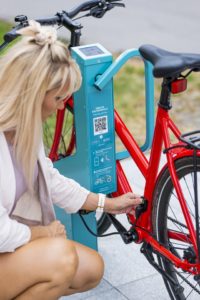Will E-mobility charger stations be critical to transport modal shift?
E-mobility is riding a wave which has gained significant momentum in the past two years. Investment in bicycles is coming from all directions: Motor manufacturers, Investment funds, and government backed initiatives spanning urban planning and active transport, motivated by clean air quality and Net Zero obligations.
Unpacking some of this, we can see a clear trend; shifting to e-mobility has moved from a purely Tesla (Battery Electric Vehicle, or BEV) dominated conversation, to one focused fairly and squarely upon micromobility, encompassing e-scooters, e-bikes, e-cargo bikes and Light Electric Vehicles (LEV). The user group got very wide, very quickly, shifting from almost exclusively Fleet and Company vehicle focused, to mass private rental and ownership, introducing micromobility as a time efficient form of transport, and an environmentally positive ‘last mile’ delivery option, to a wider society for whom a regular bicycle would never have been considered as a form of short journey transport.
The mention of Tesla is deliberate, because the charger network is a significant part of the success story for the brand. Yes, subsides to buy BEV have undeniably helped, as they have for everyone else making a BEV. However, make no mistake, it’s the Supercharger Network that’s powered Tesla sales. Think Tesla’s advantage is built on cutting edge tech merged with cool design; being an Apple style innovator? Check out the story of the Fisker Karma, which might well change that view. Without the charger network there is no Tesla success story. And it’s not just Tesla that thinks this way. Porsche (part of VW Group) has also announced plans to build its own charge network.
Now let’s think transformation around active transport for local area travel. The UK Government has invested in encouraging and supporting modal shift, to trains, to walking, to cycling, with the Transforming Cities Fund. So, the question this possess, in rural setting, town centres, and across major cities:
“Where do I charge my e-bike, my e-scooter, my e-cargo bike, my LEV?”
It’s a big question.
Don’t see it yet?
Then consider this; privately owned car parking businesses are quietly exploring making the shift to becoming charger hubs. Park and Ride scheme providers are considering offering e-bike options as bus replacements, acknowledging that e-bikes leave whenever the person is ready (no more waiting for the next bus) and move faster in urban environments, unhindered by congestion forming vehicles, waiting in line, moving at speeds slower than 100 years ago in many UK towns and cities.
In this electric vehicles (BEV and e-mobility) transition period, range anxiety remains the biggest barrier to adopting an e-mobility based form of transport. Certainly, the most frequently asked questions, prior to making an e-mobility product purchase, are, ‘what is the range when fully charged?’ coupled with, ‘how long will this take?’ ending in, ‘where/how do I charge my e-bike / e-scooter’.
The UK subsidiary of German company Gunther Spelsberg offers an answer in the form of a charger infrastructure solution, coming with app-based connectivity, or as stand-alone units.
 The charger station exists within a pre-packaged unit which requires no more than access to a 13A 240V supply, with no need to test and commission; simply plug and play. This enables rapid deployment, and in service support, for urban and rural e-mobility charging solutions. As a ‘turn-key’ solution, this is primed for:
The charger station exists within a pre-packaged unit which requires no more than access to a 13A 240V supply, with no need to test and commission; simply plug and play. This enables rapid deployment, and in service support, for urban and rural e-mobility charging solutions. As a ‘turn-key’ solution, this is primed for:
• Local government, looking to deploy a network of chargers
• Corporate office bike parking space located charger facilities
• Secure parking within a serviced apartments environment
• Installation into existing bicycle parking and shelters
Critically, with an app supported ‘connected’ unit, there is:
 • Capability to gain user based in insights, understanding how and when the facilities are used.
• Capability to gain user based in insights, understanding how and when the facilities are used.
For businesses seeking an ultra-compact solution, with an affordable price, and the option to charge customers for usage, BM E-Tech delivers a charger unit designed specifically with pubs and cafes, also hotels, hostels, and lodges in mind. Afan Lodge, prime cycling accommodation, has units installed and chose BM E-Tech specifically for the compact unit size, making it easy to install and use.
“Where do I securely park my e-bike, my e-scooter, my e-cargo bike?”
Building confidence that riding to a location is viable, as a new form of transport, will be totally undermined if access to secure storage is not available at urban and rural hub destinations.
It’s in this space which we see a number of European providers bringing years’ of experience to the UK marketplace. In both public spaces, and transport hubs, secure storage is being paired with charging, delivered as a single, integrated, solution.
 Two businesses have partnered to meet just this requirement. Bikeep and APCOA Parking (UK) Ltd are delivering Bikeep‘s secure cycle storage and e-bike charging solution to stations in the UK rail network for GTR (Govia Thameslink Railway).
Two businesses have partnered to meet just this requirement. Bikeep and APCOA Parking (UK) Ltd are delivering Bikeep‘s secure cycle storage and e-bike charging solution to stations in the UK rail network for GTR (Govia Thameslink Railway).
Bikeep CEO Kristjan Lind explains the benefits to cyclists: “With a tap of a button on your smartphone, your bike is locked securely from two points with a huge steel bar, the station is overseen by CCTV, and any distress signals are forwarded to local security whilst an audible alarm sounds. In addition, the same station charges your e-bikes while you’re away. A truly smart solution for a 21st century urban commuter.”
The powerful combination of secure storage and integrated charging solutions forms an important element in the development and delivery of mobility hubs as outlined by CoMoUK, “highly visible, safe, and accessible spaces where public, shared and active travel modes are co-located…”. The facilitation junction between community, micromobility, and formal transport networks will play a vital role in encouraging, enabling, and supporting, transport mode behaviour change.
 With connectivity at the centre of e-mobility, for host locations, providers of facilities, and for users of owned and shared micromobility, businesses such as Qi, delivering “Dock Lock Charge”, in partnership with Duckt, now part of ACTON, and Ginger – Shared Transport, enable app based findability, for storage and charging capabilities which also have an off grid adaptability, and can be engineered into existing street furniture widely found in public spaces.
With connectivity at the centre of e-mobility, for host locations, providers of facilities, and for users of owned and shared micromobility, businesses such as Qi, delivering “Dock Lock Charge”, in partnership with Duckt, now part of ACTON, and Ginger – Shared Transport, enable app based findability, for storage and charging capabilities which also have an off grid adaptability, and can be engineered into existing street furniture widely found in public spaces.
These providers, representing a small snapshot of a fast-evolving sector, are critical to achieving the goal of reducing car travel by between 20% and 30%, specifically targeting 1 to 7mile journeys, as required to achieve NetZero by 2030.
Currently cycling makes up 3% of all trips and walking 32%.
Active Travel England (ATE) the arms-length body of the Department for Transport, focused upon delivering on the Government’s ‘Gear Change’ vision, part of Boris Johnson’s so-called “golden age of cycling” – which includes the 50% active travel target – now has the job of working with public and private sector partners to deliver a transport modal shift of a kind the UK has never seen. Making e-mobility charging accessible, reliable and convenient is absolutely critical.
The humble bicycle has never been more important.



